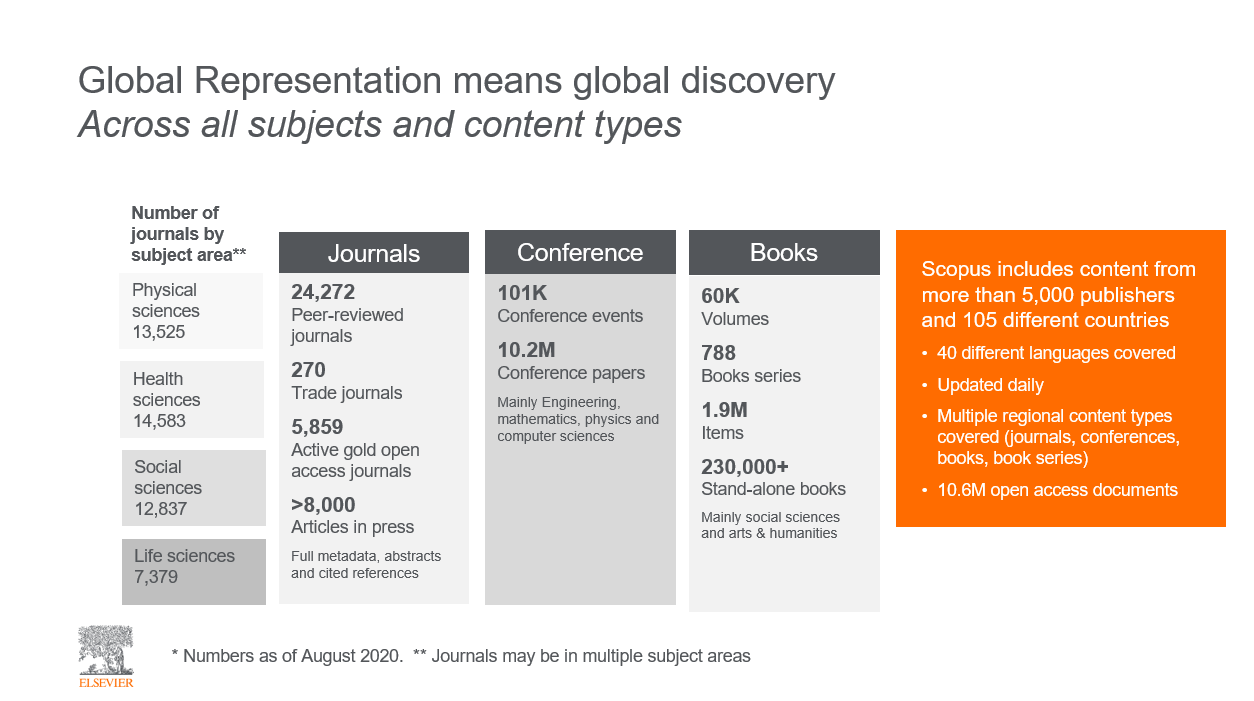Scopus Roadmap: What's coming up in 2020 & 2021?
In early 2020, we have made various updates to Scopus.com to improve search, analytics, and discovery of scientific innovation and collaborators.
We are continuously adding content
As of August 2020, Scopus has over 24,000 active titles indexed and is thereby the largest curated, peer-reviewed abstract and indexing database available to academic, government, and corporate institutions. In the past year, Scopus added 820 new journals, (+3.5% title growth). We have also added 225,000 books and book items (+11.7% growth).
Between August 2019 and August 2020, Scopus added 3.29 million new records (+4.15%). The current total number of records per August 2020 is 79.8 million.
Scopus Roadmap for the remainder of 2020 & early 2021
Enhanced Author Profiles pages
We are providing a simpler, cleaner design will enable you quickly scan an author’s profile to get an overview of their areas of expertise (via their top Topics), their productivity and publications and their research impact. The updated Author Profiles makes it even easier to search for an identify collaborators or assess researchers for tenure and promotion.
We currently have over 16 million unique Author Profiles in Scopus with a complete and accurate collection of researchers’ publications, citations and connection to their current and past institutions.
Identify Open Access content by OA type
Within the search results filters, there is currently one OA marker which covers full OA journals, hybrid journals, and open archive. We are looking to apply filters which will denote whether articles are: Gold, Hybrid Gold, Green, and Bronze.
There are currently 5,859 OA journals and 10.6 million OA articles indexed in Scopus
Pre-prints on author pages
We will introduce 600K recent pre-prints on Author Profiles giving users a view into an author’s pre-prints from the last three years and providing earlier and more comprehensive insights into their work and focus areas. With an average peer-review process of a little more than a year, users can get a head start into assessing an author’s work and potential collaboration opportunities.
Article Scopus view counts
Users will now be able to see how many times an article has been viewed in Scopus from the results screen.
The traditional citation metric indicates the value/use of an article and is therefore a lagging metric, whereas Scopus view counts are a leading indicator of quality. The views are a proxy for interest in an article, within the researcher community, and can provide users with an entry point to an area of research.
Improving integration between SciVal and Scopus
Users will be able to evaluate institutions in Scopus and SciVal more consistently due to further alignment, based on a revamp of 17,000+ institution profiles, and their respective analytical metrics
Ongoing user interface, experience, & data improvements – 2020 & beyond
The Scopus team is continuously analyzing usage and behavior trends while conducting researcher interviews to validate user flows and ensure an optimal path and user experience. These improvements include:
- Improving the home page experience by making it more personalized for users
- Assigning awarded grants to Author Profiles
- Ability to analyse the SDG search queries in Scopus
- Advancing analytical capabilities on profile pages
- Expert Lookup integration helping you to find similar or relevant researchers
- Sub-category filtering with more granular Topic areas
- Continuous Institutional Profile data clean-up by mapping subsidiaries with parent AF-IDs.
- Redesigned abstract pages to improve ease-of-use
- Improved full-text download capability: 1-click cross-publisher access to 69M full text articles
What was added earlier?
New CiteScore methodology: Introducing a more robust, fair and faster indicator of research impact.
- Fairer comparisons between peer-reviewed journals: Only peer-reviewed publication types (articles, reviews, conference papers, book chapters and data papers) are be included in the calculation, making the comparison between journals more robust. This now excludes non-peer reviewed article types: editorials, news items, letters, and notes.
- Cleaner assessment: Citations are now counted cumulatively from the year of publication through the calculation window (4 years) vs only the previous year. This means that all citations received by publications in this period are counted towards CiteScore values, and journals receive a CiteScore value 1 year earlier than an Impact Factor.
- Earlier impact indication: CiteScore is now calculated for journals with just a single year of publication, providing an earlier view into new journals’ – including many Open Access journals’ – citation impact.
Read more about CiteScore
Easier identification & tracking of experts
- Save all authors to lists: Users can now create and save ‘author lists’ for later reference. In addition, users can also save all authors from an Institution to a list from the institution profile.
- Save authors from results: Users can now save all authors to a list from “View Potential Author Matches” in search results
- Author List analytics: This new feature allows users to see analytics and metrics of a list of authors saved in their dashboard. Clicking on it will display the aggregated metrics of all the authors saved in that list.


